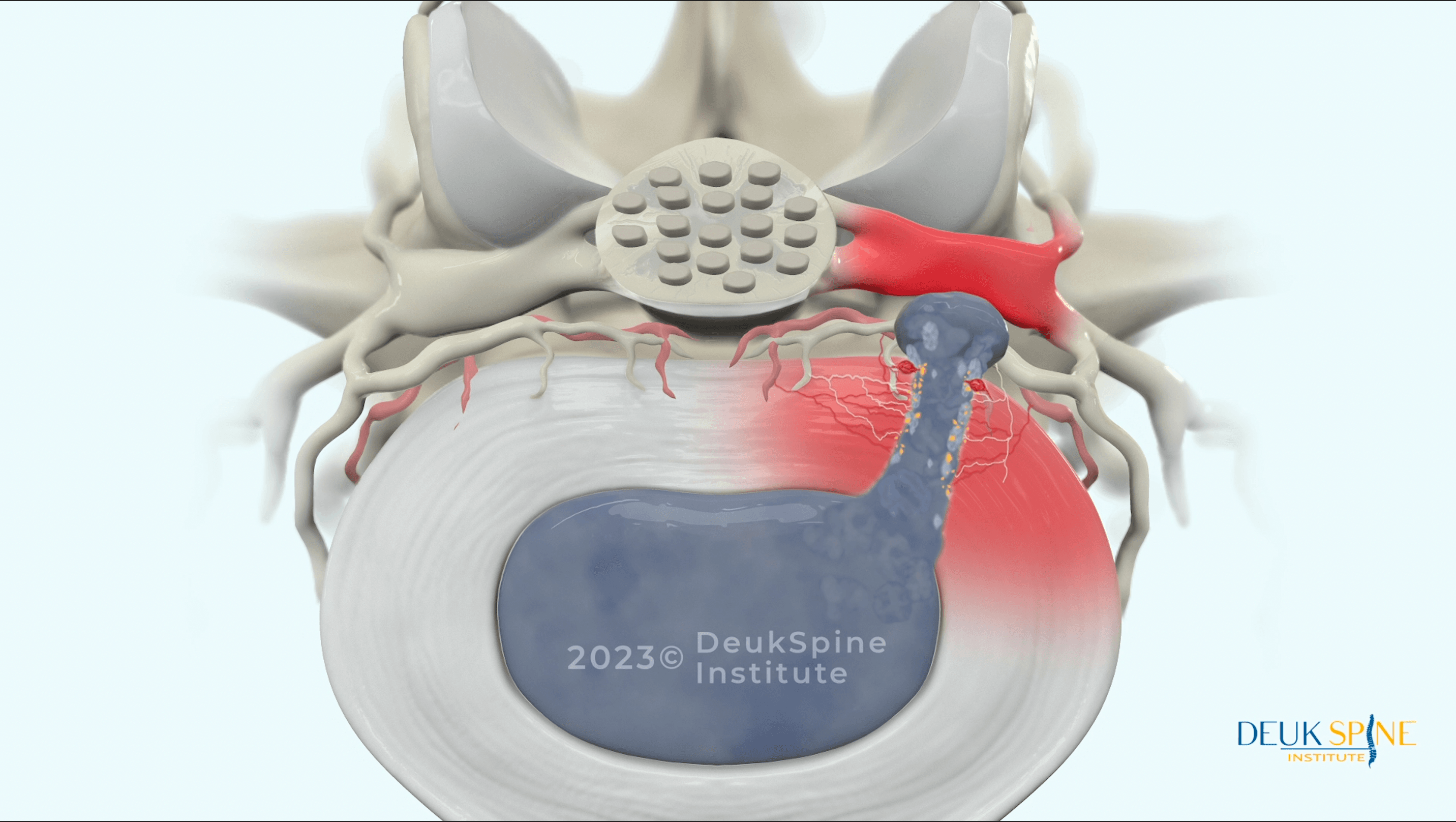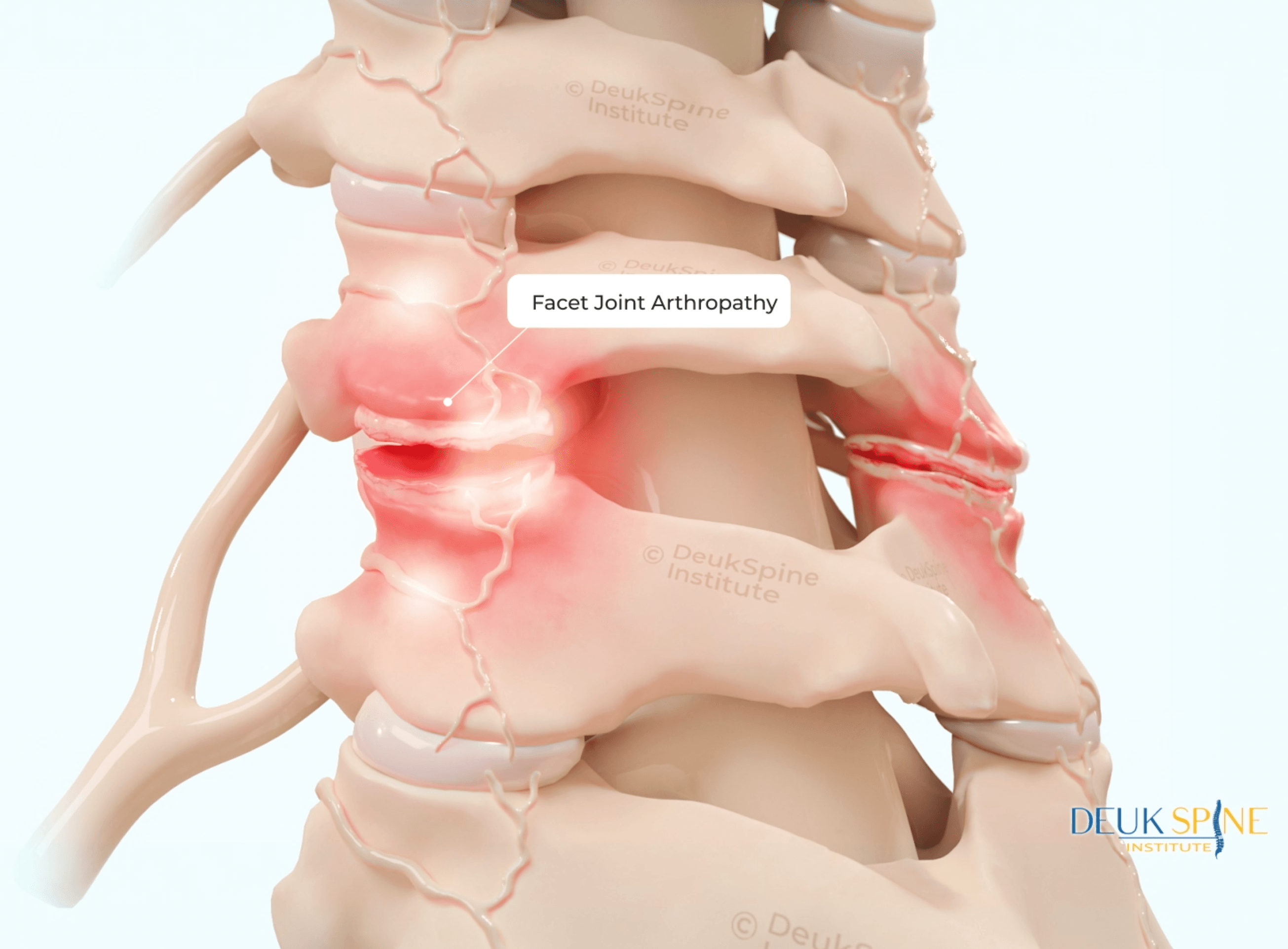The 30 Anatomical Causes of Chronic Back Pain — and How to Treat Them
Back pain can affect your ability to work, sleep, and enjoy life. When it lingers for more than six weeks, it’s considered chronic, and for many, it can start to feel like an inescapable part of daily life.
Yet chronic back pain isn’t one mysterious condition. Leading neurosurgeons recognize it as the result of specific, identifiable problems within the spine and surrounding structures. Once the true source is found, lasting relief and even a cure become possible.
At Deuk Spine Institute, Dr. Ara Deukmedjian and his team have mapped out 30 of the most common causes of chronic back pain. Nearly everyone they’ve found can be treated — and often cured — with advanced medical care tailored to the individual. For those living with ongoing pain, understanding why it hurts marks the first real step toward a pain-free life.
The Dominant Cause: Intervertebral Disc Injuries (86% of Chronic Pain)
Intervertebral disc injuries are the most common source of chronic, debilitating back pain, accounting for the majority of cases. These injuries involve the soft, cushion-like discs that sit between the vertebrae, acting as the spine’s primary shock absorbers. When they are damaged, they can cause immense pain by leaking irritating substances or by physically compressing nearby nerve roots.
The term "disc injury" covers a spectrum of pathological conditions, including:
- Disc herniations: Occur when the soft inner core (nucleus pulposus) pushes through a tear in the tough outer wall (annulus fibrosus). This can physically compress a nerve, leading to pain, numbness, and weakness.
- Disc Rupture (Distinct Pathological Manifestation): While related to herniation, a rupture can refer to a complete loss of the annular integrity.
- Disc bulges: A more generalized outward expansion of the disc.
- Annular tears or ruptures: Tearing of the disc’s outer fibrous ring, which is itself a major source of pain due to the concentration of nociceptors (pain receptors) in the annulus.
- Degenerative disc disease (DDD): The slow, progressive process where the disc loses water content and elasticity, leading to disc collapse and increased stress on other spinal components. Research shows that while age-related degenerative features are common in asymptomatic individuals, a symptomatic disc with inflammation is often the source of chronic pain.
- Combined Facet and Disc Dysfunction (Mixed Mechanical Source): Many patients have pathology in more than one structure. This is often seen when a degenerated disc places excessive pressure on the adjacent facet joints, causing both disc-mediated and facet-mediated pain, which is diagnosed and treated by identifying and addressing each unique source of pain.
- Post-Traumatic Vertebral Compression (Collapse without Full Fracture): Cases where the vertebral body is compressed or collapsed without a distinct fracture line, often seen after trauma.

The Five Lumbar Disc Levels Affected
The lumbar spine, or lower back, is the most common site of these injuries because it bears most of the body’s weight and motion. There are five lumbar discs (L1-L2, L2-L3, L3-L4, L4-L5, and L5-S1), and an injury to each represents a distinct cause of back pain.
The most vulnerable discs, in order of commonality, are:
- L4 or L5 disc injury: The most frequently affected disc level due to its location at the point of maximum spinal flexion and extension, in the lower back.
- L5 or S1 disc injury: Located right above the sacrum, this disc is the second most common site of herniation and is crucial for transferring weight to the pelvis (Deukmedjian, 2024.
- L3 or L4 disc injury: Less common than the lower two, and causes pain, numbness, tingling, and weakness in the lower back and leg.
- L2 or L3 disc injury: Rare, but can cause pain, numbness, or weakness in the hip and front of the thigh.
- L1 or L2 disc injury: Also uncommon, and can cause pain in the groin and anterior thigh.
Secondary Sources of Chronic Back Pain
While disc injuries account for the vast majority of chronic back pain, several other key anatomical structures can become sources of distress, cumulatively representing the remaining cases.
The Facet Joints

The facet joints are small, paired joints located at the back of the spine, behind the discs. They connect adjacent vertebrae, allow movement while limiting excessive rotation, and provide stability. Like any joint in the body, thee facet joints are susceptible to arthritis, degeneration, and injury, leading to a condition known as facet joint syndrome or facet arthropathy.
Each of the five lumbar levels listed above (L1–L2 through L5–S1) has a left and a right facet joint, resulting in 10 potential causes of facet-mediated pain, listed from most to least common:
- Left and right L4–L5 facet joint injury
- Left and right L5–S1 facet joint injury
- Left and right L3–L4 facet joint injury
- Left and right L2–L3 facet joint injury
- Left and right L1–L2 facet joint injury
When the facet joints are the source of pain, the pain tends to worsen with spinal extension, activity (such as arching the back), and rotation. If conservative treatments, like short-term pain management, fail, the definitive treatment for facet-mediated pain is facet medial branch rhizotomy combined with therapy. This is a specialized, minimally invasive procedure designed to safely and permanently disrupt the small nerves (the medial branch nerves) that transmit the pain signals from the joint.
The Sacroiliac (SI) Joint
The sacroiliac (SI) joint connects the triangular bone at the base of the spine (the sacrum) to the large pelvic bone (the ilium). This transfers the weight of the upper body to the hips and legs, supporting the body’s stability.
Inflammation or dysfunction of this joint, known as sacroiliitis or SI joint dysfunction, is a significant, though often misdiagnosed, cause of chronic lower back and buttock pain.
The two SI joint causes are:
- Left sacroiliac (SI) joint inflammation or dysfunction
- Right sacroiliac (SI) joint inflammation or dysfunction
A positive diagnosis often involves pain provocation tests and a diagnostic injection into the joint. Treatment options, ranging from therapeutic exercises and injections to minimally invasive procedures, are available to resolve the pain for good.
The Piriformis Muscle
The piriformis is a deep, flat muscle located in the buttocks, connecting the sacrum to the top of the femur. It is responsible for rotating the hip outward. When this muscle is strained, torn, or in chronic spasm, it can swell and entrap the sciatic nerve, which typically runs through or beneath it. This condition, piriformis syndrome, often results in debilitating pain in the buttocks that can radiate down the leg, mimicking the symptoms of a herniated disc. This radiating symptom is a form of non-discogenic sciatica.
The two causes of piriformis muscle pain are:
- Left piriformis muscle tear or syndrome
- Right piriformis muscle tear or syndrome
Piriformis syndrome can often be traced back to improper bending motions, trauma, or underlying orthopedic issues that cause people to compensate, placing excessive stress on the muscle. While injections (steroids, Botox, etc.) can offer temporary relief, they ultimately wear off. For permanent relief, a specialized, minimally invasive procedure known as the Deuk Piriformis Muscle Release® is performed through a tiny incision to release the constricted muscle tissue, permanently relieving pressure on the sciatic nerve.

Bone-Related Causes of Chronic Back Pain
The remaining causes of chronic back pain are related to trauma, structural collapse, or inflammation of the bony structures that make up the spine and pelvis.
Vertebral Body Fractures (6 Causes)
The large, cylindrical parts of the vertebrae are called vertebral bodies. When these bones are weakened by conditions like osteoporosis or cancer, or subjected to trauma, they can fracture or collapse, leading to severe, chronic pain. These injuries are known as vertebral compression fractures (VCFs).
Fractures can occur at any level of the lumbar spine and the adjacent sacrum, resulting in six distinct causes of pain:
- L1 vertebral body fracture (most common among the lumbar levels)
- L2 vertebral body fracture
- L3 vertebral body fracture
- L4 vertebral body fracture
- L5 vertebral body fracture
- Sacral fracture (a fracture of the tailbone)
Diagnosis is confirmed using imaging like X-rays, CT scans, or MRI. The treatment for VCFs typically involves a procedure such as vertebroplasty or kyphoplasty, in which bone cement is injected into the fractured vertebra to stabilize it and relieve pain. While studies on the immediate effectiveness of these injections have varied, diagnosing and treating underlying bone weakness to prevent future fractures is paramount.
Coccygeal (Tailbone) Injury or Ligament Inflammation
The coccyx, or tailbone, is the small, triangular bone at the very base of the spine. An injury to this area, typically from a direct fall onto the buttocks, can cause chronic pain known as coccydynia.
This type of chronic pain is often treated with targeted injections to the coccyx ligaments to reduce inflammation and stabilize the area.
Watch 30 Causes of Back Pain for a clear look at how each part of the spine can lead to persistent discomfort.
A Curative Treatment for Disc Pain
In the past, patients dealing with disc injuries were often offered treatments such as microdiscectomy, laminectomy, or spinal fusion—procedures that require bone removal, potentially leading to spinal instability or permanent loss of motion. However, modern advancements have introduced definitive, minimally invasive options.
The ultimate solution for disc-related chronic back pain, including bulging and herniated discs, is the Deuk Laser Disc Repair® (DLDR) procedure. This procedure directly targets and eliminates the inflamed, painful tissue associated with the annular tear and herniation, without removing bone or weakening the spine. It is performed through a tiny incision, preserving the spinal structure and offering a high success rate for a permanent cure.
To see the procedure used to eliminate chronic disc pain from levels like L4-L5 and L5-S1, view the DLDR® livestreams on the Deuk Spine Institute website.
MAKE YOUR FIRST PAIN-FREE MOVE
If you’re seeking relief from lumbar pain, have been recommended for a TLIF spinal fusion, or are still dealing with chronic neck pain after a failed fusion surgery, we can help improve your quality of life and enable you to live pain-free.
Upload your latest MRI for a free review and a personal consultation with myself. Ara Deukmedjian, M.D., founder of Deuk Spine Institute and creator of the Deuk Laser Disc Repair® procedure.

